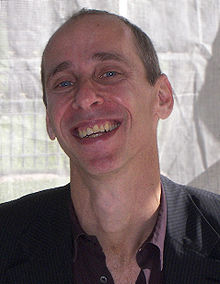Peter Maass
Peter Maass | |
|---|---|
 Peter Maass at the 2009 Texas Book Festival. | |
| Occupation | Journalist |
| Awards |
|
| Website | http://www.petermaass.com |
Peter Maass (born 1960) is an American journalist and author.
Life and career
[edit]Maass was born in Los Angeles and graduated from the University of California, Berkeley. He has worked for The Wall Street Journal, The New York Times, The Washington Post, and The New York Times Magazine. He has mainly covered international stories and has lived in Belgium, South Korea, and Hungary. In 1996 he published his first book Love Thy Neighbor: A Story of War. It told of his experiences covering the conflict in Bosnia.[1]
In 1996, Maass wrote an article for U.S. News & World Report which advocated liberalizing zoning laws to promote affordable housing for lower-income families. In the article he praised Jack Kemp for proposing this idea which was later rejected by both the George H. W. Bush and the Bill Clinton administrations.[2]
Two years later, Maass reported on the Unification Church for The New Yorker. He interviewed church members in Korea, the United States and South America, and was one of the few journalists ever permitted to attend church founder Sun Myung Moon's talks to church members.[3]
In 2003, Maass covered the Iraq War and was noted for his relationship with Iraqi blogger Salam Pax.[4] Later that year, Maass wrote a profile on North Korean leader Kim Jung Il for The New York Times Magazine which was praised for presenting information previously unknown in the English-speaking world.[5]
In 2005, Forbes magazine called Maass the "Dunce of the Week" for a New York Times Magazine cover story which predicted higher oil prices due to increased demand and decreased supply. Forbes also suggested that he had a left-wing political bias in the way he wrote the story.[6] Maass's story indirectly led to the Simmons–Tierney bet.[7] However, despite the mockery from Forbes, Maass' prediction seemed to be fairly accurate as crude oil was at $92.37 per barrel in July 2005 when Maass wrote his magazine story, and by June 2008 it reached a peak of $190.68 per barrel.[8]
On June 13, 2012, Maass received the first John M. Higgins Award for Best In-Depth/Enterprise Reporting.[9]
Maass resided at the American Academy in Berlin as a fall 2009 Berlin Prize Fellow, where he worked on his book War of Icons: From Baghdad to Berlin, a Military Writer Looks at How Pictures Frame Wars. His newest book is Crude World: The Violent Twilight of Oil.[10]
Personal life
[edit]He is married to journalist and author Alissa Quart.[11] They live in New York City.
References
[edit]- ^ His official website
- ^ Peter Maass (1996-12-22). "20 Silver Bullets: 7. How to Make Housing Affordable: Let People Subdivide Their Homes". U.S. News & World Report. U.S. News & World Report, L.P. Archived from the original on 2011-05-24. Retrieved 2008-07-29.
- ^ at Twilight, September 14, 1998 New Yorker.
- ^ Salam Pax Is Real. How do I know Baghdad's famous blogger exists? He worked for me. Slate, June 2, 2003
- ^ "The Paper Profile How Peter Maass reported the story of a reclusive dictator". poynter.org. 2003-11-14. Archived from the original on 2008-10-19. Retrieved 2008-05-04.
- ^ Dunce of the Week: Peter Maass[dead link], Forbes magazine. 2005-08-26
- ^ The $10,000 Question, The New York Times, By John Tierney, Published: August 23, 2005
- ^ "Crude Oil Prices - 70 Year Historical Chart".
- ^ "Mirror Awards 2012". Mirror Awards. S.I. Newhouse School of Public Communications Syracuse University. Archived from the original on 5 November 2012. Retrieved 20 June 2012.
- ^ The End of Oil?, By Michael Hirsh, Published: September 25, 2009, The New York Times
- ^ "Baby Einstein Is Not So Smart, After All". Oct 24, 2009. Retrieved December 12, 2009.
External links
[edit]- Official website
- Guest appearances on Charlie Rose's PBS program
- Interview on National Public Radio
- Peter Maass on Crude World: The Violent Twilight of Oil – video report by Democracy Now!
